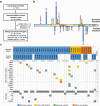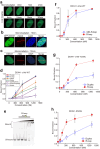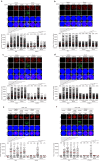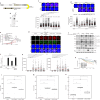Impaired binding affinity of YTHDC1 with METTL3/METTL14 results in R-loop accumulation in myelodysplastic neoplasms with DDX41 mutation
- PMID: 38514771
- PMCID: PMC11147762
- DOI: 10.1038/s41375-024-02228-4
Impaired binding affinity of YTHDC1 with METTL3/METTL14 results in R-loop accumulation in myelodysplastic neoplasms with DDX41 mutation
Abstract
DEAD box helicase 41 (DDX41) mutations are the most prevalent predisposition to familial myelodysplastic syndrome (MDS). However, the precise roles of these variants in the pathogenesis of MDS have yet to be elucidated. Here, we discovered a novel mechanism by which DDX41 contributes to R-loop-induced DNA damage responses (DDR) in cooperation with the m6A-METTL complex (MAC) and YTHDC1 using DDX41 knockout (KO) and DDX41 knock-in (KI, R525H, Y259C) cell lines as well as primary samples from MDS patients. Compared to wild type (WT), DDX41 KO and KI led to increased levels of m6A RNA methylated R-loop. Interestingly, we found that DDX41 regulates m6A/R-loop levels by interacting with MAC components. Further, DDX41 promoted the recruitment of YTHDC1 to R-loops by promoting the binding between METTL3 and YTHDC1, which was dysregulated in DDX41-deficient cells, contributing to genomic instability. Collectively, we demonstrated that DDX41 plays a key role in the physiological control of R-loops in cooperation with MAC and YTHDC1. These findings provide novel insights into how defects in DDX41 influence MDS pathogenesis and suggest potential therapeutic targets for the treatment of MDS.
© 2024. The Author(s).
Conflict of interest statement
The authors declare no competing interests.
Figures







References
MeSH terms
Substances
Grants and funding
- NRF-2022R1A4A1021318/National Research Foundation of Korea (NRF)
- NRF-2021R1A2C1006913/National Research Foundation of Korea (NRF)
- NRF-2021R1I1A1A01059572/National Research Foundation of Korea (NRF)
- NRF-2021R1F1A1052400/National Research Foundation of Korea (NRF)
- NRF-2022R1A2C2006746/National Research Foundation of Korea (NRF)
LinkOut - more resources
Full Text Sources
Medical
Research Materials
Miscellaneous

